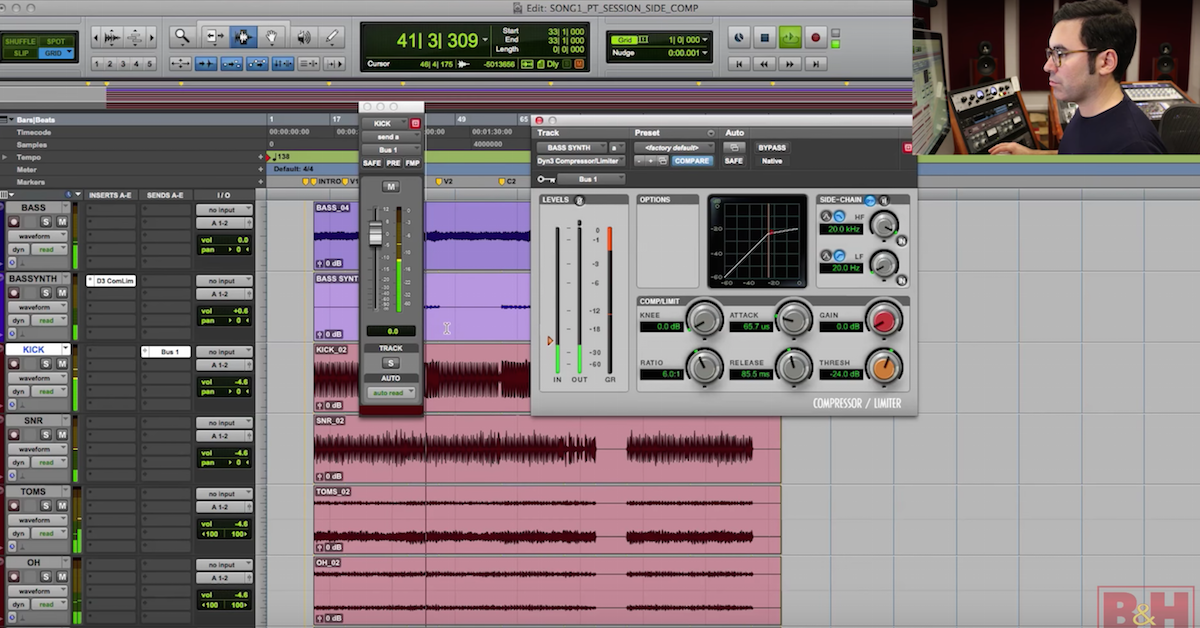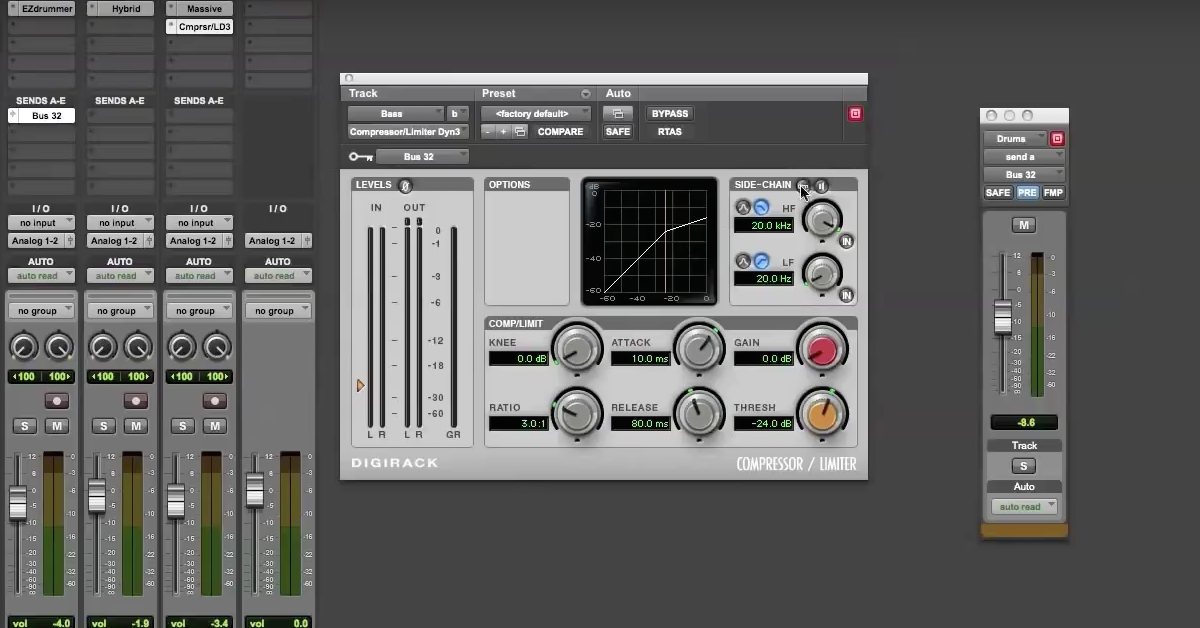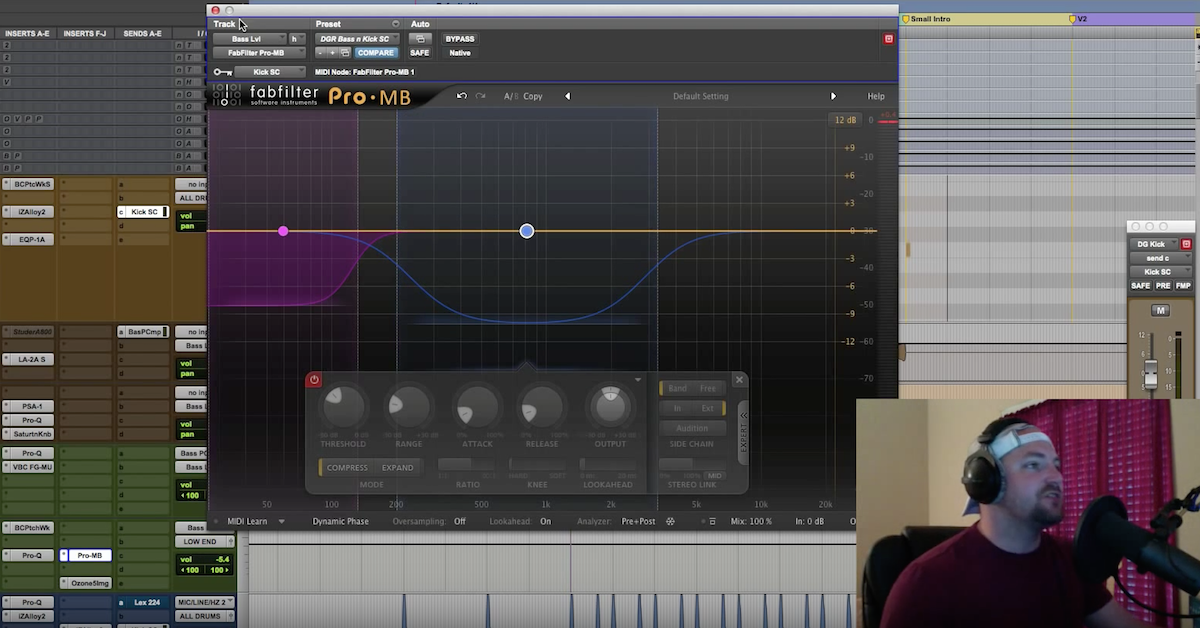What is Sidechain Compression? (+ 5 Ways to Use It)
Article Content
Sidechaining.
Based on internet goings-ons you’d think it was the ultimate solution to audio engineering. And while it’s certainly not, it is a really cool concept that allows for some great stuff to occur. In short, sidechaining is when a signal processor is controlled by a signal that’s different than the one it’s effecting. A common example would be the compressor on a bass reacting to the kick drum.
In order to understand sidechaining, we need to understand the basic architecture of a compressor.
A compressor has two circuits that work in conjunction. One is the signal path itself — that is the signal from input to attenuation to output. The other is the detector circuit which is controlling the attenuator. Another name for the detector circuit is the “sidechain” because it’s a chain of components that happens on the side of the primary signal chain.
Now, in a typical configuration, the input signal splits into the attenuation circuit and the sidechain. Many compressors allow us to effect the sidechain signal with a built-in filter. This is common in compressors designed for buss processing so that the kick drum can be diminished in the detector allowing for a more even compression action.
Some compressors, and in particular modern software compressors, have external sidechain capability. This means that a completely separate signal can be plugged into the sidechain.
This design was originally created in order to create a tone curve that would cause the compressor to act very specifically.
Custom EQ The Source Sound
Many mastering engineers have had their favorite compressor custom modified to allow an external source to hit the detector. If the mix was, say, something that was very percussion-driven, not only would we maybe want to filter out some kick, but also filter out a specific area of midrange that targets the percussion, so the compressor leaves those alone. Or if the compression action was correct but it felt too squeezed and changing the ratio reshaped the action too much, a broad dip in the midrange of the sidechain signal could alleviate that without requiring the gain to be restructured or the compressor to be over-adjusted.
Of course, there are many more examples of how this can be useful. If a vocalist strains while hitting higher notes and pushes their upper midrange, EQ’ing up the upper-mids of the sidechain signal can help reign in these over-emphasized notes.
The basic way this works is by multing the signal hitting the compressor’s input, routing the mult to an EQ, and routing the EQ’d signal to the sidechain input of the compressor. Easy.
All that said, the source sound does not need to be the same thing feeding the detector. With an external sidechain input, we can change the whole game up and set up a system of …
Ducking
A compressor, in simplest terms, turns a signal down when it detects signal amplitude. Let’s say we want a certain sound to stand out very clearly. Traditionally we would EQ competing sounds to get out of the way. Ducking offers an alternative. We can dynamically reduce the level of competing signals by setting a compressor on the competing signals that is triggered by the signal we want to stand out.
Let’s take our kick and bass example. Let’s say we want our kick to stand out a little better, but we don’t want to EQ out any of the body. We can put a compressor on the bass, and feed the kick into the sidechain. This way whenever the kick hits, the compressor kicks in and lowers the volume of the bass. If we set our compressor to act very fast and just over the transient of the kick, we can get a significant amount of clarity without really losing the bass. This same concept can work for snare being masked by heavy guitars, or even vocals competing with bright hi-hats.
But be careful because …
Less Is More with Ducking
I was mixing a record yesterday with a droning bass and round kick. I found myself in a situation where the bass was masking the kick and simple balances were leaving me either with no kick, or not enough bass. So I set up a ducking chain.
Unfortunately, the kick and bass both hit on the downbeat of the chorus and with my ducking mechanism in place the impact was just not enough for a chorus. This required some serious fine-tuning of the degree of ducking (and slowing the attack time a little bit), as well as bypassing it entirely on the first hit of the chorus. While ducking can be great for clarity, it comes at the expense of energy. And if I had to choose clarity or energy, I think energy is more important.
That said, ducking can be modified to great effect and actually create dynamic energy with what we call …
Pumping
Pumping is where the compressor’s release is clearly audible. It’s usually an unwanted artifact of setting too much compression on a very dynamic source and timing the release too fast. However, pumping can be used as a form of dynamic manipulation creating a “swelling” doing extreme compression and timing the release to feel in sync with the groove. This can be heard very commonly EDM records. It started in House but the technique has spread to Bass Music, Dubstep, Trance and Drum-n-Bass.
While each genre has its own general way of doing this, the technique always involves the kick causing other elements to duck. Sometimes it’s just the bass ducking. Sometimes it’s everything. The shape of the release is often dictated by the style. House music seems to work with a more logarithmic release which creates a less pronounced duck and a “chewier” sort of swell. Whereas Future Bass favors a more exponential release which almost sounds like the kick is punching a hole in the record every time it hits. Of course, any style is up for grabs and not necessarily genre-specific.
That’s the most audible form of ducking. If we want something more transparent we can also using ducking in …
Multiband Configurations
If we want to get clarity with a minimum audible change to the mix we can figure things in multiband mode.
This way we can duck out only the competing frequencies on a source. There are some plugins that do this very effectively such as Wavesfactory Trackspacer (which is technically a dynamic EQ … but whatever). Or we can set up our bands manually using FabFilter Pro-MB. This can be a very effective way to get something out of the way while retaining as much energy as possible.
That’s my crash course on sidechaining. The real understanding comes from putting these ideas into practice. The thinking is a little roundabout when one sound controls another, but once you get into it, it can be a very powerful technique.





